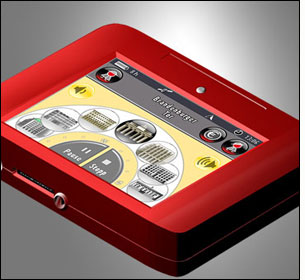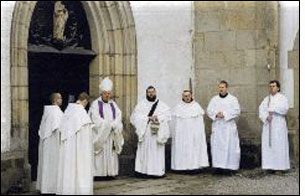A group of monks living in a 13th-century Czech monastery near the border of Austria are employing Near-Field Communication (NFC) RFID technology to provide visitors with access to recorded information in their own languages. The system’s designers say it may be one of the first NFC applications for tours and tour guides.
Tens of thousands of people each year come to the Vyšší Brod Cistercian Abbey, to visit its churches, chapels and grounds. For security reasons, given the monastery’s valuable relics, tourists must see the site in groups. If a guide is not available, a staff member must go along to unlock rooms. Often, a group is composed of visitors from around the world; this has presented a problem for those who do not speak Czech, or one of the other languages spoken by tour guides. In addition, during the off-season, language-appropriate guides are not always available.
The situation has been troublesome for the five monks who moved back into the monastery when it reopened after being closed for four decades during the country’s period of Communist rule. The monks’ main source of income is tourism, and they need to ensure a steady flow of visitors in order to bring in sufficient revenue to support them, as well as pay for repairs to the site, which had fallen into disarray during the Communist era.
The Association for the Support of the Cistercian Monastery Vyšší Brod, an organization that supports the monks and their monastery, sought a simple solution to provide visitors with access to information in their own languages.
Klaus Zerbs, who heads the association, knew of a technology center in nearby Hagenberg, Austria, where NFC solutions provider Nexperts is based (see NFC Research Lab Rolls Out Smart Posters). Zerbs contacted the firm to see if it had technology suitable for the monastery’s needs. Nexperts began designing a solution, and the association applied for funds from the European Union to help cover some of the project costs, which were roughly €17,000 ($24,000). The monks will be reimbursed for approximately €12,000 ($17,000) through the European Territorial Cooperation (ETC) initiative.
Nexperts had originally considered implementing a system that would offer visitors information via NFC-enabled mobile phones. However, the company believed the phones might not have enough battery life for the application, and that they could be easily damaged if dropped. Therefore, the firm turned to Cruso, a Berlin-based manufacturer of devices that provide text, graphic and audio information to museumgoers. The two companies worked to outfit those devices with NFC RFID interrogators.

Some Cruso devices also make it possible for tourists to load and redeem tickets on them, and provide GPS capabilities for use in walking tours, for example. According to Zerbs, the monastery may add such functions at a later point.
Visitors who rent one of the 20 NFC-enabled devices used at the monastery select their desired language and then approach an NFC-enabled touch point, an insulated disk 20 centimeters (8 inches) in width that displays a picture of the monastery. The disks, which contain a 13.56 MHz passive RFID tag complying with the NFC standards, are mounted on iron stands with heavy bases to keep them from falling over easily. A visitor can wave the Cruso device in front of one of the 15 touch points, and the device presents multimedia information regarding the important sights adjacent to that particular touch point.
Kurd Schmid, Nexperts’ CEO, says the system allows for a unique user experience, since it simplifies the process of obtaining information about the monastery’s various sights. What’s more, he muses, the contrast between the modern technology and the historic setting is striking.
“The solution has turned out remarkably,” Zerbs says. “We now have four languages, and we’ll add four more. For the monks, it means they now have a solid source of income.”


